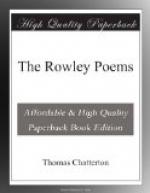Yet it seemed obvious that the antiquaries would demand to see the manuscript, and Chatterton, contrary to his usual practice of secrecy, called upon his friend Rudhall and, having made him promise to tell nothing of what he should show him, took a piece of parchment ‘about the size of a half sheet of foolscap paper,’ wrote on it in a character which the other did not understand, for it was ’totally unlike English,’ and finally held what he had written over a candle to give it the ‘appearance of antiquity,’ which it did by changing the colour of the ink and making the parchment appear ’black and a little contracted.’ Rudhall, who kept his secret till 1779 (when he bartered it for L10, to be given to the poet’s mother, at that time in great poverty), believed that no one was shown or asked to see this document. Why, it is impossible to say.
The present volume contains a reproduction[2] in black and white of the original MS. of Chatterton’s ‘Accounte of W. Canynges Feast’. This was written in red ink. The parchment is stained with brown, except one corner, and the first line written in a legal texting hand. The ageing of his manuscript of the Vita Burtoni, to take a further instance, was effected by smearing the middle of it with glue or varnish. This document was also written partly in an attorney’s regular engrossing[3] hand. During the next four years Chatterton ‘transcribed’ a great quantity of ancient documents, including AElla, a Tragycal Enterlude—far the finest of the longer Rowleian poems—the Songe to AElla and The Bristowe Tragedy (the authorship of




